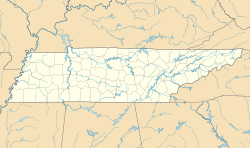Beaver Dam Plantation facts for kids
Quick facts for kids |
|
|
William Cannon Houston House
|
|
| Location | 107 Houston Ln. Woodbury, Tennessee |
|---|---|
| Area | 28 acres (11 ha) |
| Built | 1810s; c. 1870; c. 1930 |
| Architectural style | Greek Revival |
| NRHP reference No. | 89000503 |
| Added to NRHP | June 16, 1989 |
The Beaver Dam Plantation, also known as the William Cannon Houston House, is a very old and important house in Woodbury, Tennessee, USA. It's a large, historic home that was once part of a big farm called a plantation.
Contents
History of Beaver Dam Plantation
Early Days and Growth
The story of Beaver Dam Plantation began around 1810. At first, it was just a simple log building. Later, a politician named William C. Houston bought the land in 1873. He made the plantation much bigger.
Mr. Houston built the main mansion in the early 1870s. His son, Frank K. Houston, was born right there on the plantation. Frank later became the head of a big bank called Chemical Bank (now CITIBANK).
Over the years, the house changed. A fancy dining room was added around 1880. A back porch was built around 1930.
Unique Geode Pillars
The house is famous for its amazing pillars made of geodes. Geodes are special rocks with crystals inside. The six brothers of the family built these pillars. They got help from farmhands. The pillars were a special anniversary gift for Judge Houston and his wife, Lizzie Minor McLemore Houston.
A Trading Post and Historic Stop
Beaver Dam started as a trading post. This was a place where people traded goods, especially furs. The name "Beaver Dam" came from a funny argument. A fur trader named McFerrin doubted if a pelt was truly from a beaver!
The plantation was also a stopping point on the "Trail of Tears." This was a sad time when the Cherokee Nation was forced to move from their homes to Oklahoma. This happened because of President Andrew Jackson's orders.
Civil War and Family Stories
During the American Civil War, Beaver Dam was a camp for soldiers. General Nathan Bedford Forrest's 4th Tennessee Cavalry stayed here. They camped before their attack on Murfreesboro.
Family stories say that Judge W.C. Houston met his future father-in-law here. He was Colonel William S. McLemore. However, other family stories suggest young Houston was hidden. He might have been kept safe in caves to avoid joining the Confederate Army. He was only ten or eleven years old at the time.
A Community Hub
Beaver Dam was always a busy place in Cannon County. It was where people signed up to join the army. This happened for many wars, from the War of 1812 to World War I.
The plantation sits along Tennessee's first state highway. This road was known as "State Route One." It connected Memphis to Bristol. Many important politicians visited the historic home. These included Sam Rayburn, James F. Byrnes, John Nance Garner, and Cordell Hull.
Judge Houston was also a Presidential Elector. This meant he helped choose the President of the United States.
Farming and Innovation
William C. Houston was also a smart farmer. He built the first grain silo in the county. A silo is a tall building used to store grain. The plantation grew crops like tobacco and wheat. They also raised Tennessee Walking Horses and cattle. Until 1973, the plantation covered a huge area of 800 acres.
Architectural Style
Greek Revival Design
The Beaver Dam mansion was built in the Greek Revival style. This style was popular in the 1800s. It looks like ancient Greek temples. It often features tall columns and grand entrances.
The house is so important that it is listed on the National Register of Historic Places. It was added to the list on June 16, 1989. This means it is a special historic site.



